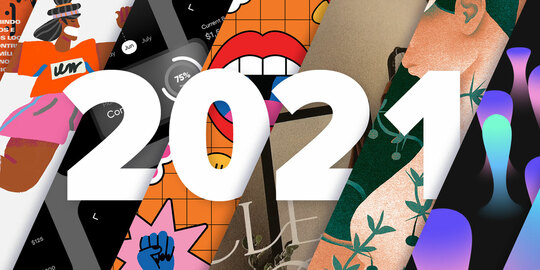Graphic Design Trends for 2021
Brands are in constant search of the cutting edge that'll give them an advantage over their competitors. They want access to novel technologies and software first. They want to be able to undercut their competitors' pricing with more efficient working practices. They also want their branding to be superior to their competitors.
This mindset even extends to the aesthetic of the business. Every brand wants their aesthetic to be geared towards maximum appeal. Failing to constantly tailor and refine your image to stay relevant runs the risk of obsolescence.
Apple's relentless appetite for change -even if slight can breathe new life into tired, outdated and overexposed design.
If you're hoping to revamp your existing aesthetic or come up with an entirely new one, here are a few of the themes you can expect to see in design this year.
Bold and brash psychedelia
The 60s have been long considered a source of inspiration for fashion, music and design.
And one of its exports - psychedelia - has enjoyed a redemptive arc in 2021.
It has long been associated with music and art and people are still obsessed with co-opting the experimentation and rebellion of the era.
It still holds a massive amount of cultural cachet. Very few making purchasing decisions were in their adult years during the 60s. That kind of distance and remove lends even more weight to the sheen of cool that the 60s has.
For bold and forward-thinking brands keen to position themselves at the vanguard of the shopping world, it's a no-brainer to borrow visuals from the decade. A psychedelic design ensures that whatever it is you're designing - whether it's packaging, the product itself or an advertising campaign - it won't be short of eyeballs.
Psychedelic designs are often a brash, kaleidoscopic dash of color and intrigue that is impossible to tear your eyes away from.
Still, it should be used with caution. There are some negative connotations to psychedelia: specifically its association with mind-altering substances.
But if you're in an industry that isn't beset with stuffy conservatism, the striking visuals of psychedelia are definitely worth considering.
Pop art/ comics
Design has always been cyclical and graphic designers are always mining the past for ideas for their work. One popular style of artwork that has undergone a renewed surge of popularity is pop art.
The historic success of superhero franchises like The Avengers is perhaps partly responsible for this trend. Classic typefaces, grainy colours and design with a bold, black outline have all emerged as one of the common threads that unites designers in 2021.
It undeniably adds a sense of fun and vibrancy to otherwise staid and conservative design. Pop art is relatively simple to imitate yet it creates a sense of punch.
Nostalgia can be a powerful motivator and sometimes the mere suggestion of a bygone era is enough to tempt an audience to dip their toes into a new product.
Embracing the natural world
Pandemic restrictions have forced us to spend more time than ever before trapped inside our own homes. Understandably, this has led to a yearning for the outside world.
This desire has been reflected in the design choices of brands in 2021.
Incorporating design elements borrowed from the natural world portrays freshness, newness and health - all important associations for consumers - especially in the healthcare, skin and haircare industries.
Embracing the natural world in a way that isn't clichéd or already overdone can be a challenge.
Some of the common signifiers of the natural world: leaves, flowers and greenery are all likely to be commonplace in the design world in the upcoming months.
These sorts of motifs also lend themselves to being tied in with another hot topic: sustainability.
With so many companies keen to stress their commitment to protecting the planet, adopting the aesthetic of the natural world is an obvious choice.
And even if this design isn't necessarily an accurate reflection of their sustainability practices, using iconography borrowed from the natural world is a sneaky way to at least create the impression that your brand has an environmental conscience.


